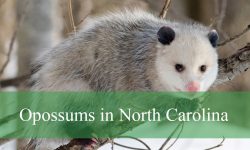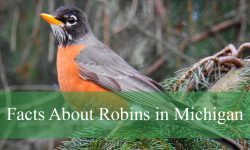California is home to a wide variety of amphibians, and frogs are among the most familiar and fascinating. From lush forests to arid foothills and urban ponds, frogs in California occupy a broad range of habitats. Their calls, colors, and behaviors add life to wetlands and signal the health of local ecosystems.
Frogs in California come in all shapes and sizes, from tiny treefrogs that cling to grasses to larger species like the American Bullfrog. Some are native and play essential roles in the environment, while others are invasive and compete with local wildlife. Learning to identify these species can enhance any nature outing and support local conservation efforts.
This guide highlights 10 common frogs in California with clear pictures and identification tips. It’s designed to help you recognize these unique amphibians, understand their habitats, and appreciate their role in California’s diverse landscapes.
Common Frogs Found in California
American Bullfrog (Lithobates catesbeianus)
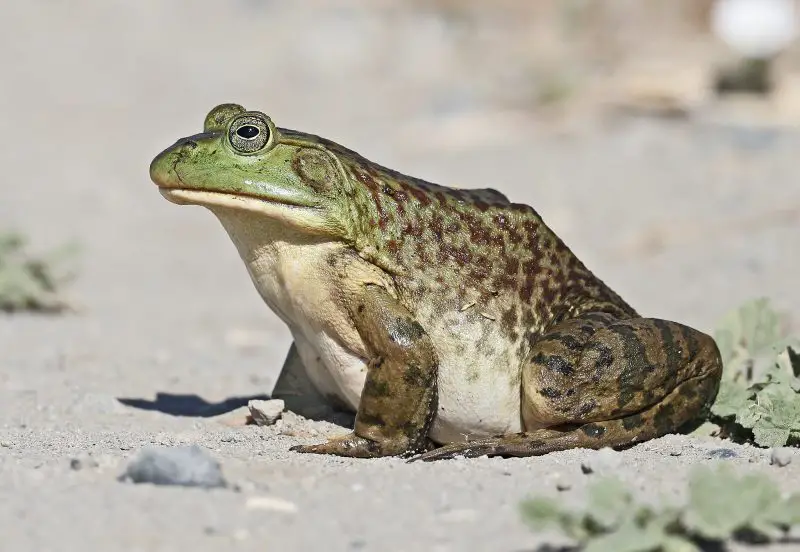
The American Bullfrog is the largest frog species found in California, reaching up to 15 cm (6 inches) in length and weighing as much as 680 grams (1.5 pounds). Its skin is typically olive green, sometimes appearing with gray or brown mottling. One of its most distinguishing features is the large, circular tympanum (eardrum) located behind the eye. Males have yellowish throats, while females usually have lighter, cream-colored throats.
This species thrives in calm aquatic habitats, such as ponds, lakes, marshes, and slow-moving canals. It prefers warm, still waters with abundant vegetation along the margins. American Bullfrogs are primarily aquatic but may venture onto land near water sources during certain times of the day or breeding seasons.
As an invasive species in California, the American Bullfrog poses a significant ecological threat. It preys on a wide range of native wildlife, including insects, small fish, amphibians, reptiles, and even birds. Their large size and aggressive feeding habits contribute to the decline of native frog populations and disturb local ecosystems.
Originally native to the eastern United States, this species was introduced to California and other western states in the early 20th century. Today, it is widespread throughout much of the state, particularly in lowland areas with permanent bodies of water. Its presence is considered a management concern for conservation efforts.
Northern Leopard Frog (Lithobates pipiens)
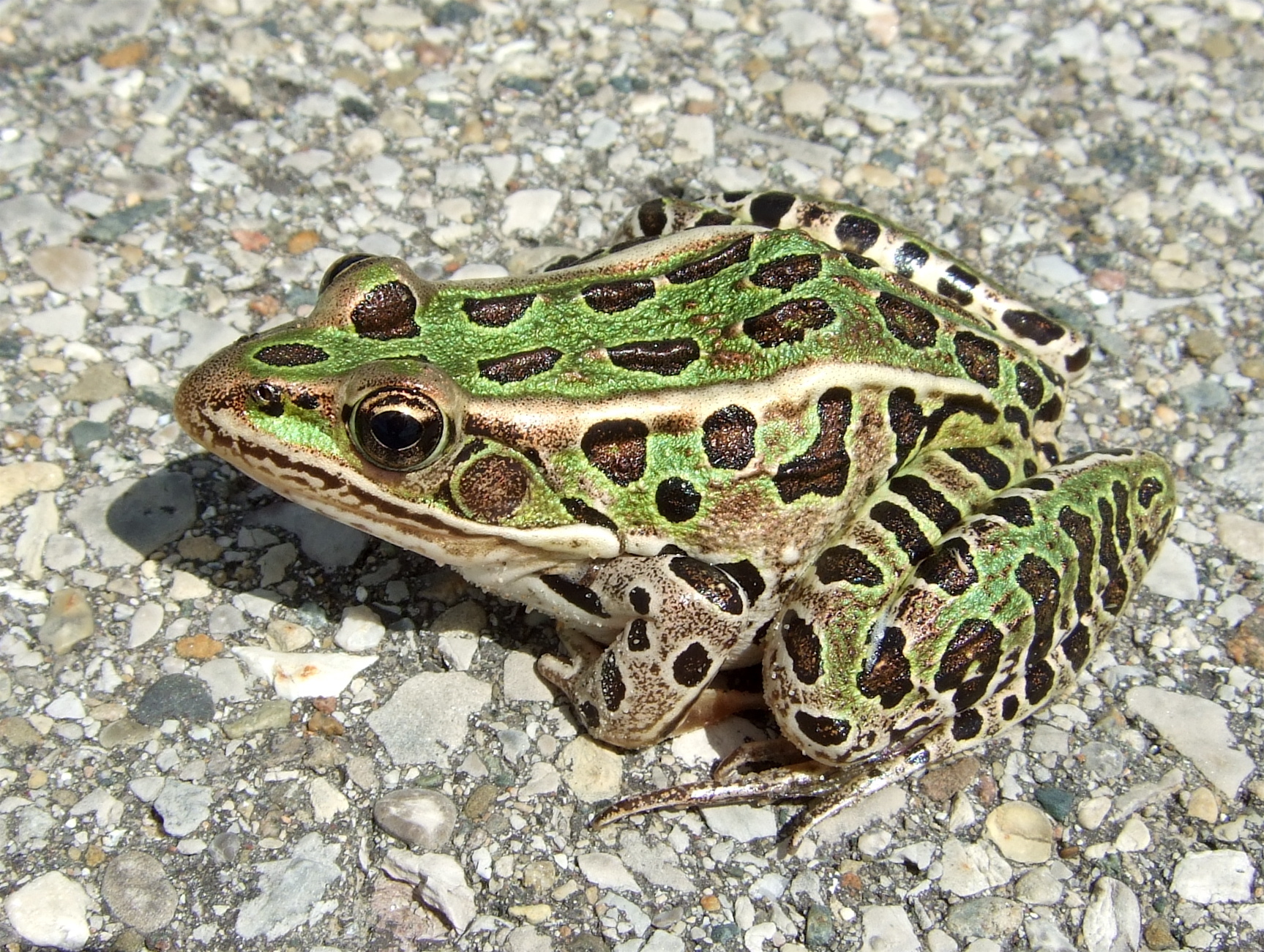
The Northern Leopard Frog is easily recognized by its vibrant green to brown coloration and distinctive large, dark spots scattered across its back and legs. These spots often have light borders, adding to their leopard-like appearance. The skin is smooth, and the species features two prominent light-colored dorsolateral folds running along each side of the back.
These frogs prefer habitats with slow-moving or still water, such as ponds, marshes, slow streams, and lakes. They are also commonly found in nearby grassy or marshy areas where they can forage. The species relies on healthy, unpolluted aquatic environments for breeding and feeding.
Northern Leopard Frog populations in California are currently in decline. Factors contributing to this include habitat destruction, prolonged droughts, water pollution, the introduction of non-native species like predatory fish and bullfrogs, and the spread of fungal diseases like chytridiomycosis. Conservation efforts are underway in parts of California to stabilize remaining populations.
Although once more widespread, this species is now largely confined to a few remnant populations in northeastern California and select areas along the Sierra Nevada. They are considered a species of special concern and are monitored closely by wildlife agencies.
Pacific Treefrog (Pseudacris regilla)

The Pacific Treefrog is a small but charismatic amphibian, typically growing to about 5 cm (2 inches) in length. It exhibits a wide range of colors, including green, tan, and brown, often with mottled patterns. A dark stripe extends from the nostril through the eye and down to the shoulder, serving as a key identifying feature. Its underside is pale, usually creamy or white.
This adaptable frog species can be found from sea level to elevations exceeding 3,000 meters (about 10,000 feet). It inhabits a variety of environments, including woodlands, grasslands, coastal scrub, and chaparral. It is most commonly observed near ponds, streams, and temporary pools, especially during the rainy season.
Pacific Treefrogs are excellent climbers but spend much of their time on the ground or low vegetation. They are highly vocal, with males producing loud, distinctive calls often heard during and after rainfall. Their calls are a familiar sound in many parts of California, especially in spring.
This species is widespread throughout California and is considered one of the most common amphibians in the state. Their wide distribution and adaptability to both natural and human-altered landscapes have allowed them to thrive, despite regional pressures from habitat loss and pollution.
California Treefrog (Pseudacris cadaverina)

The California Treefrog is a small, cryptically colored amphibian, usually measuring about 5 cm (2 inches) in length. Its coloration ranges from pale gray to light brown, often with darker blotches that allow it to blend seamlessly with its rocky surroundings. Unlike other treefrogs, its skin is noticeably rough, helping it stay camouflaged in dry, rugged habitats.
These frogs are typically associated with rocky streambeds and moist canyon areas, especially in foothill and mountain regions. They are most often found beneath rocks or within crevices close to flowing water. Their preference for cool, shaded riparian zones limits their range compared to more adaptable species.
While they are usually calm, California Treefrogs can become aggressive toward other males during the breeding season. They use physical displays and low croaking calls to establish dominance and attract mates. Outside of the breeding season, they remain relatively inconspicuous.
This species is native to Southern California and northern Baja California. It is primarily found in the Peninsular and Transverse mountain ranges, especially in the Santa Ana, San Bernardino, and San Jacinto Mountains. Though considered locally abundant in some areas, habitat degradation poses a long-term concern.
Baja California Treefrog (Pseudacris hypochondriaca)
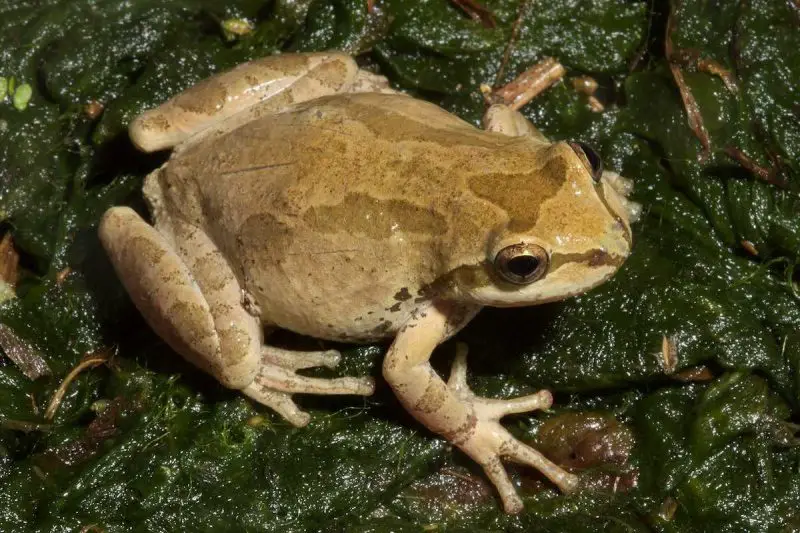
The Baja California Treefrog closely resembles the Pacific Treefrog, with slight differences in coloration and skin patterning. It generally measures about 5 cm (2 inches) in length and varies in color from green to brown, sometimes even gray. A distinctive dark stripe runs from the snout through the eye and down to the shoulder, though the intensity of this marking can vary among individuals.
Its habitat includes a range of environments in Southern California and Baja California, Mexico. It is commonly found in coastal sage scrub, woodlands, and mountainous areas with access to seasonal water sources. Like its close relatives, it uses ephemeral pools and wetlands for breeding.
Although it typically stays near the ground, the Baja California Treefrog has good climbing ability and may be found in low shrubs or tree branches. It is also known for its distinctive “ribbit” call, which is often heard during mating season or after heavy rainfall.
This species is most prevalent in the southern parts of California, particularly in San Diego, Riverside, and Imperial Counties. Its population remains stable, and it is frequently encountered in both natural and suburban areas. Its adaptability to human-altered environments helps it persist despite increasing urbanization.
Sierran Treefrog (Pseudacris sierra)
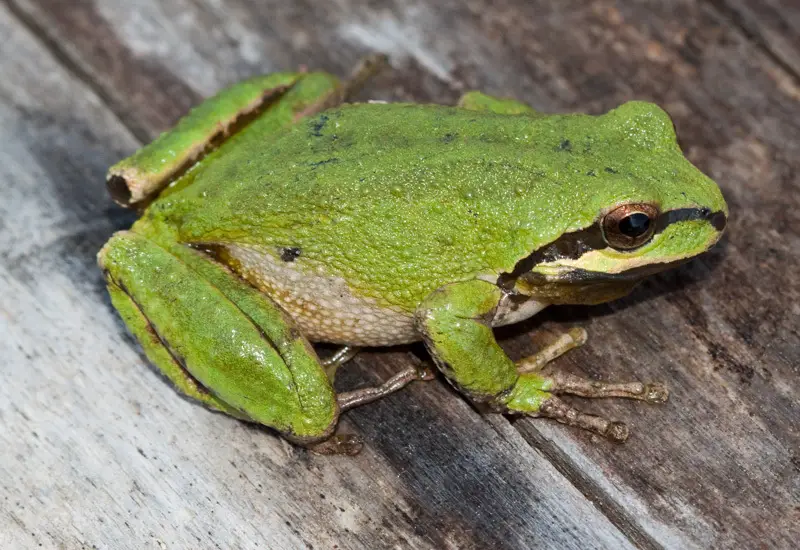
The Sierran Treefrog, formerly grouped under the Pacific Treefrog complex, is a small, colorful amphibian that typically reaches about 5 cm (2 inches) in length. Its coloration ranges from vibrant green to rich brown, often with dark mottling or irregular blotches. A defining feature is the dark stripe running from the nostril, through the eye, and extending to the shoulder, offering easy identification in the field.
This species inhabits high-altitude environments in the Sierra Nevada range of California. It is commonly found at elevations between 3,350 and 3,650 meters (11,000–12,000 feet), particularly in moist meadows, coniferous forests, and rocky stream areas. The frog’s coloration allows it to blend into mosses, rocks, and vegetation in its mountainous habitat.
Although it is called a treefrog, the Sierran Treefrog primarily lives on the ground. It is, however, capable of climbing low vegetation and rocks when needed. During the breeding season, males vocalize near shallow pools and meltwater streams to attract females. The calls are distinctive and can often be heard echoing through alpine meadows during spring and early summer.
This species is native to California’s Sierra Nevada and adjacent mountain ranges, and while not currently under significant conservation threat, it remains vulnerable to environmental changes, such as drought, climate shifts, and habitat disturbance from recreational use in alpine areas.
Foothill Yellow-legged Frog (Rana boylii)
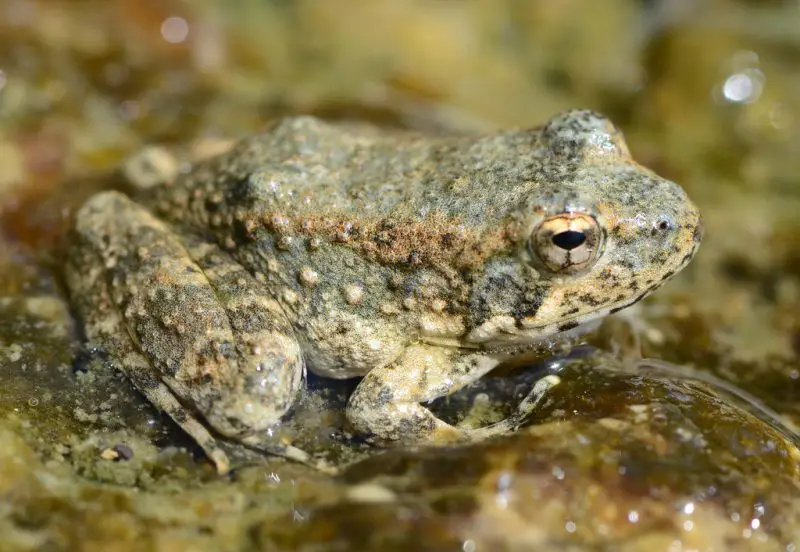
The Foothill Yellow-legged Frog is a medium-sized amphibian, generally measuring between 4 and 8 cm (1.5 to 3 inches) in length. Its skin ranges in color from earthy browns to gray, often mottled with irregular spots. One of its most distinctive features is the yellow coloration found on the underside of its hind legs and groin area, which gives the species its common name.
This species favors low-elevation streams and rivers, particularly in the foothills of the Sierra Nevada and the coastal ranges, such as areas in and around the Los Padres National Forest. It thrives in clean, well-oxygenated water with rocky or gravel substrates, where it can lay eggs and find shelter among submerged rocks and vegetation.
Foothill Yellow-legged Frogs are diurnal and can often be seen basking on rocks near stream banks. They are sensitive to environmental disturbances and prefer undisturbed watercourses with consistent flow patterns. During the breeding season, which typically begins in late spring, males use a soft, throaty call to attract females to shallow pools.
This species is currently listed as threatened in California and endangered at the federal level due to a range of threats, including damming, sedimentation, habitat fragmentation, water pollution, and the introduction of non-native predators. Conservation efforts are focused on habitat restoration and population monitoring throughout their historical range.
Red-legged Frog (Rana aurora)
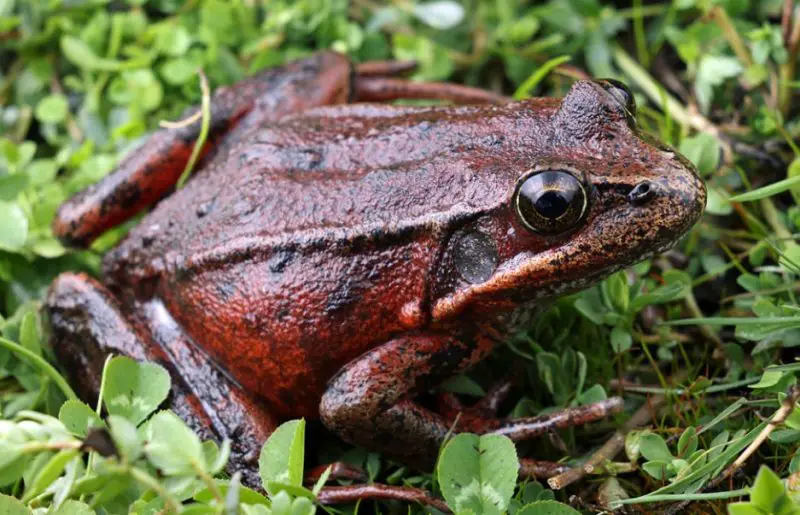
The Northern Red-legged Frog is a medium-sized amphibian native to the Pacific Northwest and a portion of Northern California. Adults typically measure between 5 and 10 cm (2 to 4 inches) in length. Their skin is smooth, and their coloring ranges from reddish-brown to olive with dark spots and a subtle red hue on the underside of the hind legs, which gives the species its name.
This frog inhabits cool, moist environments, particularly in coastal forests, freshwater marshes, and shaded creeks. In California, its range is limited to the far northwestern part of the state, where it prefers quiet, still waters with ample vegetative cover and clean substrates for breeding.
Red-legged Frogs are generally nocturnal and are most active during wet conditions. During breeding season, males emit a low, stuttering call underwater. Unlike some frogs, they do not call from the surface, making them harder to detect. They feed on invertebrates and contribute to local food webs as both predator and prey.
Due to their limited distribution in California and sensitivity to environmental change, these frogs are considered an important indicator species for wetland health. Habitat degradation, pollution, and competition from invasive bullfrogs have all contributed to population declines in recent decades.
California Spotted Frog (Rana pretiosa)
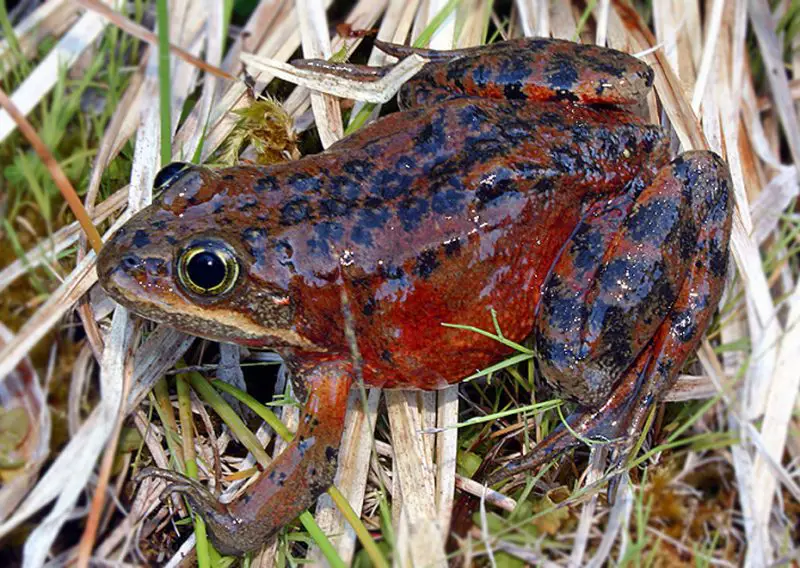
The California Spotted Frog, more commonly known as the Oregon Spotted Frog, is a rare amphibian whose range historically included parts of Northern California. It is medium-sized, usually measuring between 4 and 10 cm (1.5 to 4 inches). This frog has a reddish-brown or olive background with distinctive black spots and a reddish-orange wash on its underside, especially around the legs and belly.
It inhabits permanent freshwater environments like wetlands, marshes, and slow-moving streams. These frogs require year-round standing water and are most often found in warm, shallow areas with ample vegetation for cover. In California, its known distribution is very limited and possibly extirpated in some historical sites.
The California Spotted Frog is largely aquatic and rarely ventures far from water. It is diurnal and often basks in shallow water or on floating vegetation. Breeding takes place in early spring, and females lay egg masses attached to submerged vegetation in sunny, shallow pools.
This species is federally listed as threatened due to drastic population declines linked to habitat loss, wetland draining, water management practices, and predation by non-native species. In California, extensive conservation efforts are focused on habitat restoration and reintroduction programs to help recover any remaining populations.
American Green Treefrog (Hyla cinerea)

The American Green Treefrog is a vibrant, slender species that is typically 3.5 to 6.5 cm (1.5 to 2.5 inches) long. It is easily recognized by its bright green skin, often with a yellowish or white stripe running from the jaw down the flanks. The skin is smooth, and the large, sticky toe pads are well-adapted for climbing and gripping vegetation.
Although not native to California, the American Green Treefrog has been occasionally documented in the southern part of the state. These rare sightings are often due to accidental introductions via landscaping materials or the pet trade. They are more commonly found in the southeastern U.S., where they inhabit swamps, wetlands, and bayous.
In areas where it appears in California, this species tends to occupy human-altered habitats like garden ponds, greenhouses, or ornamental water features. It is primarily nocturnal, becoming active at dusk to hunt insects and call during the breeding season with a sharp, repetitive “queenk, queenk” sound.
While not established in the wild across California, the presence of this species raises concern about potential impacts on native amphibians. Vigilance is required to prevent it from becoming invasive, especially in sensitive habitats where it could compete with or displace local frog species.

